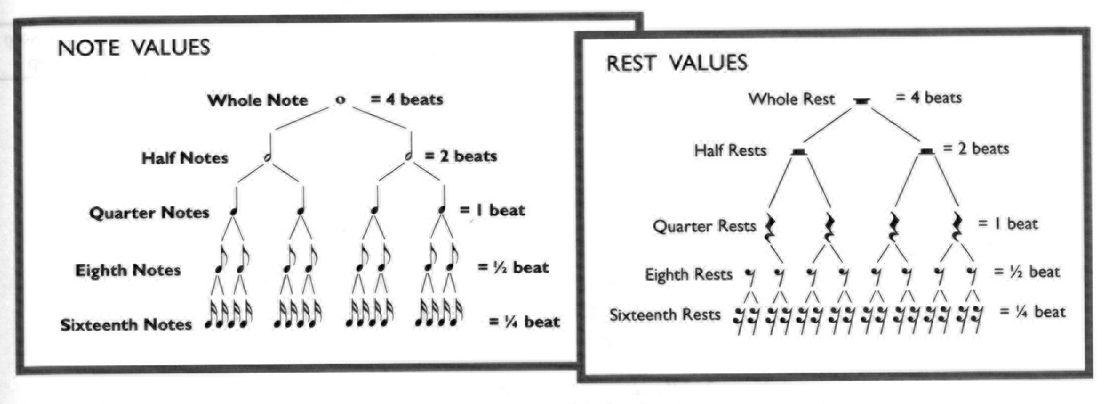Introduction to Music
for those wanting to become musicans, or improve their musicianship
Note and Rest Values
Now that we know what the letter names of the Treble and Bass clef are, we need to learn about note and rest types and their values as well as an introduction to rhythm.
Shown are the most common note and rest values that you are likely to run across in most music. There is one longer value and at least 3 faster note & rest values. A note’s value tells you how long the note lasts in relation to the other notes. It does not tell you how fast a note is. Read that again, it’s important. (How long the note lasts refers to how much time there is between the time the first note sounds and the next note sounds). All notes have a proportional relation to one another.
(For any readers familiar with the British system of crotchets, minims, quavers and my favorite, hemi-demi-semi-quaver, you’ll have to convert from that to this system which is typically used in North America and elsewhere).
Rests represent silence in music. Yes, silence is an important part of music. With rests, you have no sound for the value indicated. It does not mean to stop. The beat keeps going. That is, there should be silence for the amount of time the rest indicates.
The longest note or rest, the whole note is twice as long as a 1/2 note. The 1/2 note is twice as long as a 1/4. A 1/4 is twice is long as an 1/8 and a 1/8 is twice as long as a 16th. To put it another way, a 1/2 note is twice as fast as a whole, a 1/4 is twice as fast as a half, a 1/8 is twice as fast as a 1/4 and finally, a 1/16 is twice as fast as an 1/8. Whether you describe the notes in terms of longer or faster than one another, it is always twice as much as you move from one value to another. I recommend picking one or the other methods of describing the note relationships and stick to that while learning the note and rest values.
Try tapping a steady, non-stopping, steady beat on one leg while tapping out the various note values on the other leg. For example, you would tap one leg twice for every single time the other leg is tapped in order to indicate eighth (1/8) notes.
Next time: Measures and rhythm


5 replies on “Introduction to Music, Part 4 (Note values)”
Reblogged this on duART Studio Blog.
Reblogged this on right beat radio.
Hemidemisemiquaver is a bit of a mouthful and must sound almost comical to American ears but the advantage of semibreve, minim, crotchet, quaver and semiquaver, at least, is that the expressions precisely identify a note type regardless of time signature. The term ‘quarter note’ loses some of its significance in, for example, 12/8 or 5/4 time and I question the habit of using the semibreve as the target duration. Waltzes, polkas, jigs etc. were far more common in the very early days of music.
We (in the UK) refer to ‘notes’ not ‘tones’ partly to avoid confusion with the interval of a tone.
National differences are troublesome for all of us. The US letter size causes problems throughout the rest of the world, especially when printing off web pages, as does the continued use of feet and inches. We all went metric years ago.
I understand that many non-English speaking countries use totally different systems for music too. I don’t ever hear anyone use the term “tones” in the US. At least someone who can read music, no matter where they learned, can play with someone else, no matter the system or terminology.
Strange, James. In my experience ‘tones’ is common in the US. Being able to play with others began with extemporized music and with group ‘busking’ but, I agree, more complex arrangements need organization to avoid chaos.